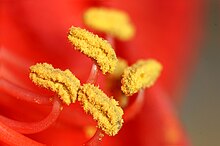| Part of a series on |
| Evolutionary biology |
|---|
 |


Evolution of sexual reproduction describes how sexually reproducing animals, plants, fungi and protists could have evolved from a common ancestor that was a single-celled eukaryotic species.[1][2][3] Sexual reproduction is widespread in eukaryotes, though a few eukaryotic species have secondarily lost the ability to reproduce sexually, such as Bdelloidea, and some plants and animals routinely reproduce asexually (by apomixis and parthenogenesis) without entirely having lost sex. The evolution of sexual reproduction contains two related yet distinct themes: its origin and its maintenance. Bacteria and Archaea (prokaryotes) have processes that can transfer DNA from one cell to another (conjugation, transformation, and transduction[4]), but it is unclear if these processes are evolutionarily related to sexual reproduction in Eukaryotes.[5] In eukaryotes, true sexual reproduction by meiosis and cell fusion is thought to have arisen in the last eukaryotic common ancestor, possibly via several processes of varying success, and then to have persisted.[6]
Since hypotheses for the origin of sex are difficult to verify experimentally (outside of evolutionary computation), most current work has focused on the persistence of sexual reproduction over evolutionary time. The maintenance of sexual reproduction (specifically, of its dioecious form) by natural selection in a highly competitive world has long been one of the major mysteries of biology, since both other known mechanisms of reproduction – asexual reproduction and hermaphroditism – possess apparent advantages over it. Asexual reproduction can proceed by budding, fission, or spore formation and does not involve the union of gametes, which accordingly results in a much faster rate of reproduction compared to sexual reproduction, where 50% of offspring are males and unable to produce offspring themselves. In hermaphroditic reproduction, each of the two parent organisms required for the formation of a zygote can provide either the male or the female gamete, which leads to advantages in both size and genetic variance of a population.
Sexual reproduction therefore must offer significant fitness advantages because, despite the two-fold cost of sex (see below), it dominates among multicellular forms of life, implying that the fitness of offspring produced by sexual processes outweighs the costs. Sexual reproduction derives from recombination, where parent genotypes are reorganised and shared with the offspring. This stands in contrast to single-parent asexual replication, where the offspring is always identical to the parents (barring mutation). Recombination supplies two fault-tolerance mechanisms at the molecular level: recombinational DNA repair (promoted during meiosis because homologous chromosomes pair at that time) and complementation (also known as heterosis, hybrid vigour or masking of mutations).
- ^ Letunic, I; Bork, P (2006). "Interactive Tree of Life". Retrieved 23 July 2011.
- ^ mLetunic, I; Bork, P (2007). "Interactive Tree of Life (iTOL): An online tool for phylogenetic tree display and annotation" (PDF). Bioinformatics. 23 (1): 127–8. doi:10.1093/bioinformatics/btl529. PMID 17050570.
- ^ Letunic, I; Bork, P (2011). "Interactive Tree of Life v2: Online annotation and display of phylogenetic trees made easy" (PDF). Nucleic Acids Research. 39 (Web Server issue): W475–8. doi:10.1093/nar/gkr201. PMC 3125724. PMID 21470960.
- ^ Otto, Sarah (2014). "Sexual Reproduction and the Evolution of Sex". Scitable. Retrieved 28 February 2019.
- ^ Redfield, Rosemary J. (August 2001). "Do bacteria have sex?". Nature Reviews Genetics. 2 (8): 634–639. doi:10.1038/35084593. PMID 11483988. S2CID 5465846.
- ^ Goodenough, U.; Heitman, J. (1 March 2014). "Origins of Eukaryotic Sexual Reproduction". Cold Spring Harbor Perspectives in Biology. 6 (3): a016154. doi:10.1101/cshperspect.a016154. ISSN 1943-0264. PMC 3949356. PMID 24591519.